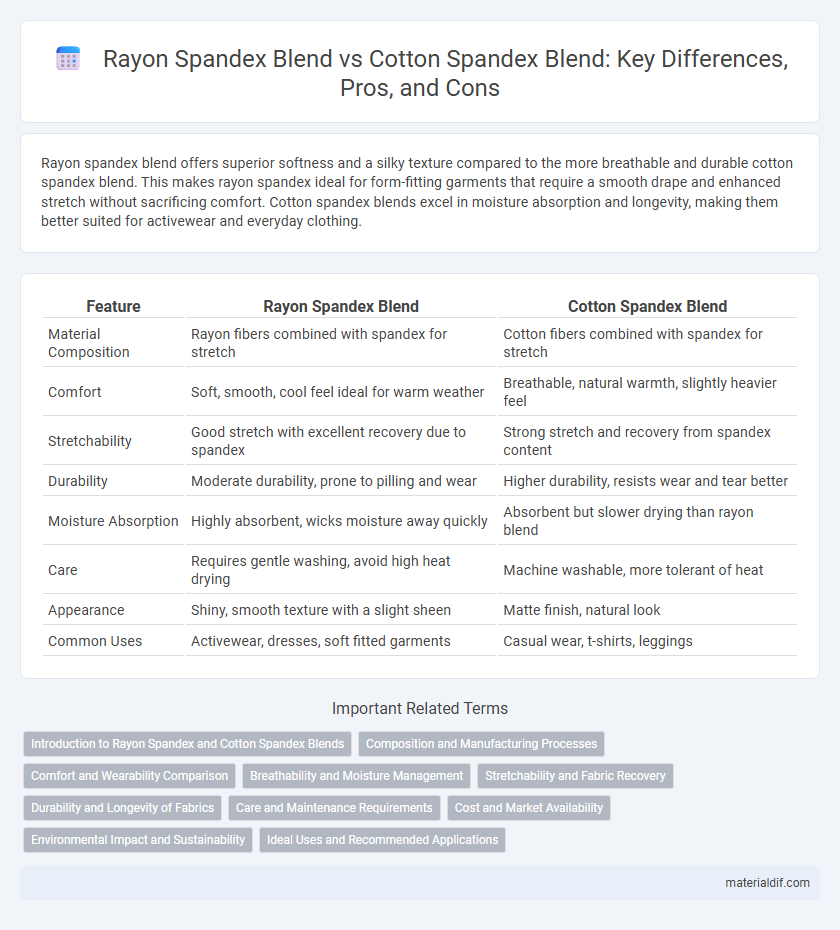Rayon spandex blend offers superior softness and a silky texture compared to the more breathable and durable cotton spandex blend. This makes rayon spandex ideal for form-fitting garments that require a smooth drape and enhanced stretch without sacrificing comfort. Cotton spandex blends excel in moisture absorption and longevity, making them better suited for activewear and everyday clothing.
Table of Comparison
| Feature | Rayon Spandex Blend | Cotton Spandex Blend |
|---|---|---|
| Material Composition | Rayon fibers combined with spandex for stretch | Cotton fibers combined with spandex for stretch |
| Comfort | Soft, smooth, cool feel ideal for warm weather | Breathable, natural warmth, slightly heavier feel |
| Stretchability | Good stretch with excellent recovery due to spandex | Strong stretch and recovery from spandex content |
| Durability | Moderate durability, prone to pilling and wear | Higher durability, resists wear and tear better |
| Moisture Absorption | Highly absorbent, wicks moisture away quickly | Absorbent but slower drying than rayon blend |
| Care | Requires gentle washing, avoid high heat drying | Machine washable, more tolerant of heat |
| Appearance | Shiny, smooth texture with a slight sheen | Matte finish, natural look |
| Common Uses | Activewear, dresses, soft fitted garments | Casual wear, t-shirts, leggings |
Introduction to Rayon Spandex and Cotton Spandex Blends
Rayon spandex blends combine the smooth, breathable texture of rayon with the stretch and recovery properties of spandex, making them ideal for comfortable, form-fitting garments. Cotton spandex blends offer natural softness and moisture absorption, enhanced by spandex's elasticity for better fit and flexibility. Both blends are popular in activewear and casual clothing due to their balance of comfort, durability, and stretch retention.
Composition and Manufacturing Processes
Rayon spandex blend consists primarily of regenerated cellulose fibers derived from wood pulp combined with synthetic spandex fibers, offering a smooth, breathable fabric with excellent stretch recovery. Cotton spandex blend fabric is made from natural cotton fibers intertwined with spandex, providing durability, moisture absorption, and elasticity. Manufacturing rayon spandex involves chemical processing of cellulose and fiber spinning techniques, while cotton spandex blends undergo traditional cotton harvesting and spinning, then knit or woven with spandex for stretch.
Comfort and Wearability Comparison
Rayon spandex blends offer superior moisture-wicking properties and a silky, smooth texture that enhances overall comfort and breathability compared to cotton spandex blends. Cotton spandex blends provide natural fiber softness and durability but can retain more moisture, potentially reducing comfort during extended wear. The elasticity of spandex combined with rayon's drape results in garments that maintain shape while feeling lightweight, making rayon spandex blends preferable for activewear and fitted clothing.
Breathability and Moisture Management
Rayon spandex blends offer superior breathability compared to cotton spandex blends, allowing better air circulation and keeping the body cooler during physical activities. The moisture-wicking properties of rayon enhance moisture management by quickly absorbing sweat and facilitating faster evaporation, reducing discomfort and chafing. In contrast, cotton spandex blends tend to retain moisture longer, which can lead to a damp feeling and slower drying times.
Stretchability and Fabric Recovery
Rayon spandex blends offer superior stretchability and excellent fabric recovery, making them ideal for activewear and fitted garments that require flexibility and shape retention. Cotton spandex blends provide good stretch but often lack the same level of elasticity and may lose shape faster after repeated wear. The viscose nature of rayon fibers enhances softness and durability, contributing to better overall comfort and resilience in fabric recovery compared to cotton-based blends.
Durability and Longevity of Fabrics
Rayon spandex blends typically offer superior softness and stretch but may have lower durability compared to cotton spandex blends, which are known for their higher tensile strength and resistance to wear and tear. Cotton spandex fabrics maintain longevity due to cotton's natural durability and the elastic recovery provided by spandex, making them ideal for activewear and frequent use. In contrast, rayon spandex blends require more delicate care to preserve fabric integrity over time, as rayon fibers are more prone to pilling and weakening with repeated washing.
Care and Maintenance Requirements
Rayon spandex blends require gentle washing with cold water and air drying to prevent fabric shrinkage and maintain elasticity, while cotton spandex blends are more durable and can often tolerate machine washing and tumble drying on low heat. Both blends benefit from avoiding bleach and high heat to preserve fiber integrity and stretchability. Proper care extends the lifespan of blends by minimizing pilling and fabric distortion.
Cost and Market Availability
Rayon spandex blends generally cost more than cotton spandex blends due to the complex production processes involved in rayon manufacturing. The market availability of rayon spandex blends is more limited compared to cotton spandex blends, which are widely accessible due to cotton's abundant cultivation and established supply chains. Consumers seeking affordability and broader variety often prefer cotton spandex blends, while rayon spandex blends appeal to niche markets valuing a softer, silk-like texture.
Environmental Impact and Sustainability
Rayon spandex blends typically have a higher environmental impact than cotton spandex blends due to the intensive chemical processing and water usage required to produce rayon from wood pulp. Cotton spandex blends, especially those using organic cotton, tend to be more sustainable because cotton is a natural fiber that can be grown with fewer chemicals and less energy, though conventional cotton production still poses ecological challenges. Choosing organic cotton spandex blends reduces pesticide use and soil degradation, making them a more eco-friendly option compared to rayon spandex blends.
Ideal Uses and Recommended Applications
Rayon spandex blend offers excellent stretch and breathability, making it ideal for activewear, casual wear, and lightweight summer apparel where comfort and fluid drape are essential. Cotton spandex blend provides durability and moisture absorption, making it suitable for everyday basics, denim, and athleisure garments requiring softness with structural integrity. Both blends excel in form-fitting clothing but differ in texture and moisture management, influencing their recommended applications.
Rayon Spandex Blend vs Cotton Spandex Blend Infographic

 materialdif.com
materialdif.com